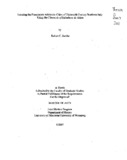| dc.contributor.author | Jacobs, Robert C. | |
| dc.date.accessioned | 2010-06-21T16:05:54Z | |
| dc.date.available | 2010-06-21T16:05:54Z | |
| dc.date.issued | 2007 | |
| dc.identifier.citation | Jacobs, Robert C. Locating the Franciscans within the Cities of Thirteenth Century Northern Italy Using the Chronicles of Salimbene de Adam; A thesis submitted to the Faculty of Graduate Studies in partial fulfillment of the requirements of the degree of Master of Arts, Joint Masters Program, Department of History, University of Manitoba/University of Winnipeg. Winnipeg, Manitoba, Canada: University of Manitoba & University of Winnipeg, 2007. | |
| dc.identifier.uri | http://hdl.handle.net/10680/19 | |
| dc.description.abstract | In 1210, a young man later to be canonized as St. Francis went to Pope Innocent III and obtained permission to form a new religious order that was radically different from any order that had gone before. In the beginning this order, the Franciscans, disdained the ownership of any material goods, rejected any contact with the developing commercial society of the communes and disapproved of papal privileges. By the last decades of the thirteenth century, the order found its relationships with the community greatly altered. This thesis traces these changes as revealed in the Chronicle of Salimbene de Adam a Chronicle written by a young man who joined the Order in 1238. It examines the increasingly close relationship between the Franciscans, the civic administration, the secular church, and the papacy and the mutual benefits that resulted. It investigates the conflict between the local clergy and the order and notes how important the order's close relationship with the papacy was to their ability to triumph in conflicts with local clergy. The thirteenth century saw many spontaneous religious movements that sprang into existence. The Franciscans frequently saw these new movements as competitors and this thesis documents the four methods that the Franciscans developed to deal with them. The close contact with the secular world resulted in significant changes in the Order itself. The assumption by the Order of pastoral service necessitated its acquisition of elaborate buildings. More important and less obvious were changes taking place in the Order itself. There was an increasing regard for social class inside the Order, which eventually led to the near exclusion of lay members from the Order. This thesis describes these changes as they took place in the first seven decades of the Order's existence. | en_US |
| dc.description.sponsorship | University of Winnipeg and University of Manitoba | en_US |
| dc.description.uri | http://winnspace.uwinnipeg.ca/bitstream/handle/10680/19/Jacobs_Robert_Thesis.pdf | |
| dc.language.iso | en | en_US |
| dc.publisher | University of Manitoba & University of Winnipeg | en_US |
| dc.rights | info:eu-repo/semantics/openAccess | |
| dc.subject | Chronicles of Salimbene de Adam | en_US |
| dc.subject | Franciscan Order | en_US |
| dc.subject | Italy, thirteenth century | en_US |
| dc.title | Locating the Franciscans within the Cities of Thirteenth Century Northern Italy Using the Chronicles of Salimbene de Adam | en_US |
| dc.type | Thesis | en_US |
| dc.description.degree | Master of Arts in History | |
| dc.publisher.grantor | University of Manitoba & University of Winnipeg | |
| thesis.degree.discipline | History | |
| thesis.degree.level | masters | |
| thesis.degree.name | Master of Arts in History | |
| thesis.degree.grantor | University of Manitoba & University of Winnipeg | |

